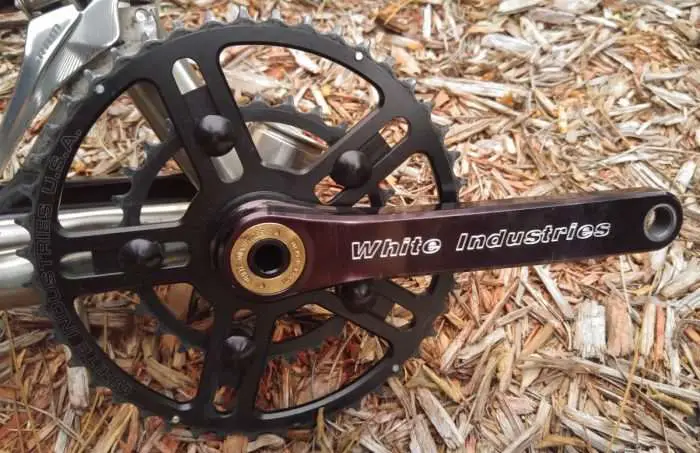
“We are one of the few remaining bicycle component manufacturers who continue to manufacture our goods here in the USA. We are proud that we can say of our components: Made in the USA. Our team works together as a family on all aspects of the business from engineering to machining, from assembly to the sales and support of the components we produce. We are located in Petaluma, California located in Sonoma County. We take pride in the components we produce, in the quality that we put forth, and the customer service that we offer to you. ”
White Industries MR30 Crankset – Technical Details
MR30 cranks come in three flavors:
- M30 Mountain.
- G30 Gravel / Adventure.
- R30 Road.
“For a long time square taper was king, but in recent years the development of new axle standards have redefined crank and drivetrain standards. We, at White Industries, answer this change by offering the MR30 cranksets.”
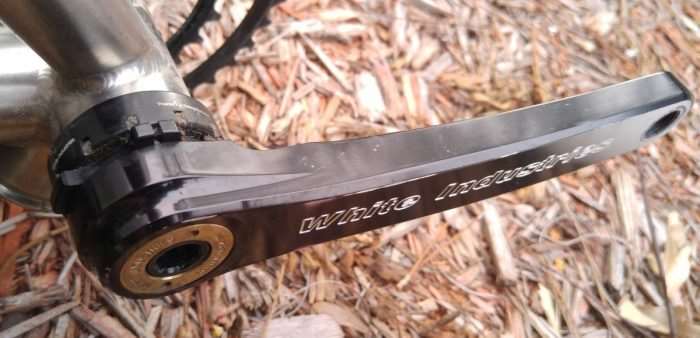
“The G30 is our adventure gravel crankset. The crank arms are designed to give you the spacing for wider tires while the narrow aluminum 30mm spindle allows you to keep a tight streamlined chain line. This crank is built around a 68/86mm bottom bracket and available in both the TSR 1x narrow wide and VBC 2X drive train configurations. BSA, T47, or Press Fit 30 compatible, available in either black anodized or silver polished with the option of colored extractor bolts.”
Gravel Cyclist is all about gravel, but this review is centered around the R30 road crankset, as the crankset was destined for installation on JOM’s Ritchey Breakaway CX gravel travel bike. Additionally, JOM prefers a narrow Q-factor, and the R30’s measure 157.2mm, whereas the G30 gravel crank measures 171mm.
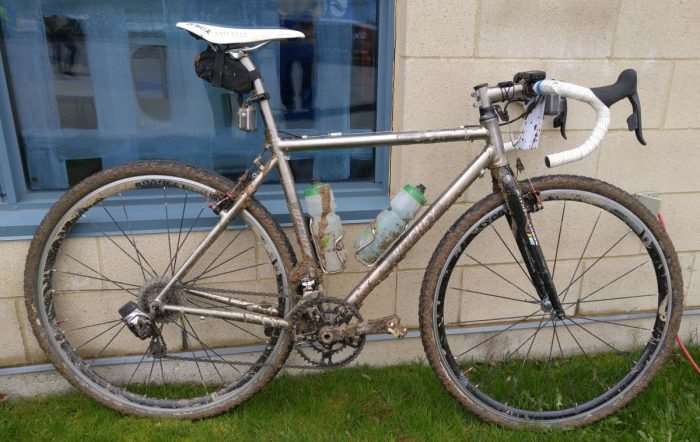
“The R30 is our do it all road crank using our long-standing VBC, variable bolt circle, design. The VBC system is built around a 68/86mm bottom bracket and allows you to customize your 2x ring configuration by being able to mix and match your inner and outer ring to create the ultimate gearing suitable for whatever ratio you desire.”
Everything else about the R30 is identical to the G30 crankset in terms of 1x and 2x compatibility, and the same bottom bracket systems.
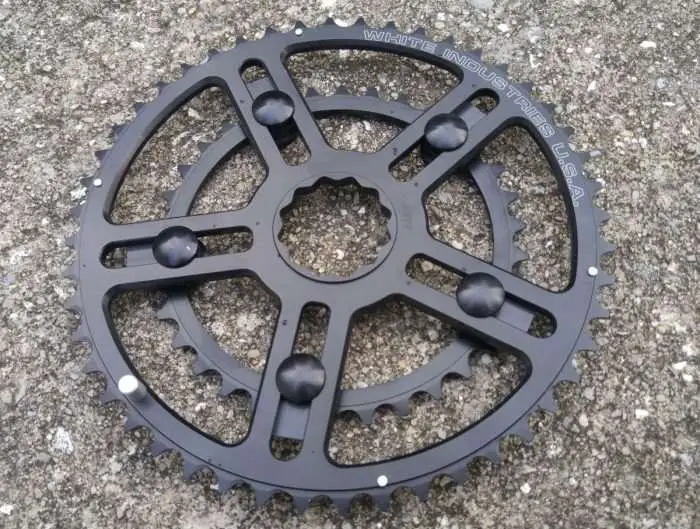
“VBC is an acronym for Variable Bolt Circle. The beauty of VBC rings is they allow you to set up various tooth configurations to get the gear ratio you desire.”

“The outer ring is designed with a slotted section and the inner five bolt ring is self-centering allowing more options when compared to traditional crank designs with set bolt circle requirements.”
White Industries recommend at least a ten tooth difference between the outer gear and the inner gear and a maximum of 24 teeth. Thus, you can configure extremely low gear ratios for dirt and gravel use – or whatever you desire – the VBC chainrings are compatible with 9, 10 and 11-speed drivetrains. Available chainrings are 24 – 38 for the inner ring in even increments and 38 – 52 for the outer, again in even increments.
The review sample with everything to provide a functional crankset and bottom bracket system tipped the scales at 864.8 grams.

Our test bike utilizes a BSA / English thread 68mm bottom bracket. We chose the White Industries BSA bottom bracket with its oversized 30mm spindle, a perfect match for the R30 crankset. We chose the Stainless Steel bearing set, but White Industries offers a ceramic bearing upgrade at a premium – $US 250.00 versus $US 100.00 for Stainless Steel.
Bottom Bracket and Crankset Installation
To install the White Industries 30mm bottom bracket, you’ll need a Park Tool BBT-79 installation tool.
In the case of this installation, an English threaded bottom bracket shell, ensure the shell is clean before applying a suitable amount of grease to the shell threads. In the case of my test bike, a titanium frameset, I applied a liberal slathering of anti-sieze compound in addition to a very thin layer of teflon tape (optional).
I didn’t have the cup torque specifications available at the time of installation, but I tightened down both cups ensuring a snug fit and no chance of the cups backing out under normal pedaling load. For press-fit bottom brackets, you’ll have to follow a wee bit different procedure.
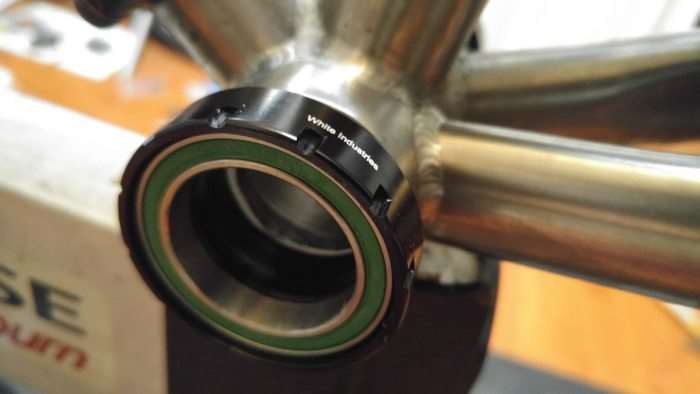
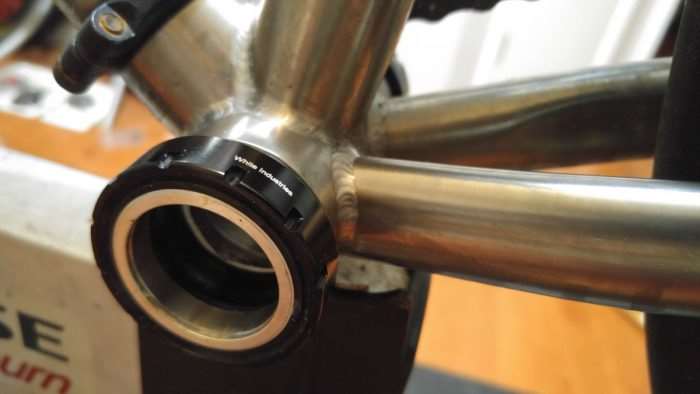
Install the bottom bracket spindle, ensuring you apply plenty of grease to the known contact points. The easiest method of installation is to mate the spindle to the non-drive side crank arm, and slide the spindle through from the non-drive side.
Install each crankarm and tighten the self-extracting bolt on each side to appropriate torque. The recommended torque is 48-54nm but if you don’t have a torque wrench, that will be about as tight as you can go with a full-length 10mm allen key. This advice came directly from Alex of White Industries.

With the crank arms installed, the final step it to thread the adjustment ring (resides on the non-drive side) towards the frame until the bottom bracket spindle no longer slides back and forth. Ideally, there will be little to no side to side play and the crank arms should spin freely. If the crank does not spin freely, slowly thread the ring away from the frame until the crank spins freely. Once in the optimal position, tighten the small bolt in the adjustment ring with a 1.5mm allen key.
Swapping out Chainrings
The really nice thing about this crankset design is the relative ease of swapping out chainring sets. With that said, I ordered the R30 crankset with a 46/30 ring set installed, and a 48/34 ring set as a spare if I decided to go a little bigger. Thus far, this crankset has remained at one with my gravel travel bike and the 46/30 ring set has stayed, but swapping to the 48/34 as one module is pretty simple to do.

To install or remove the big chainring from the crank – this process applies to 1x or 2X chainrings – you’ll need the Park Tool BBT-22 or BBT-32 – see above photo for an example of the procedure. When tightening, the lockring holding the chainring in place should be torqued to 40 Nm.
How does the White Industries R30 crankset perform?
Perfect is the word. It has been ridden extensively on training rides and at these events for 11 months:
- 2016 Taiwan KOM Challenge, a non-gravel climbing event.
- 2017 Paris to Ancaster.
- 2017 Almanzo 100.
- 2017 Crusher in the Tushar.
During this time, the crankset has been paired with a SRAM eTap drivetrain and Shimano Ultegra 6800 series 11-32 cassettes.
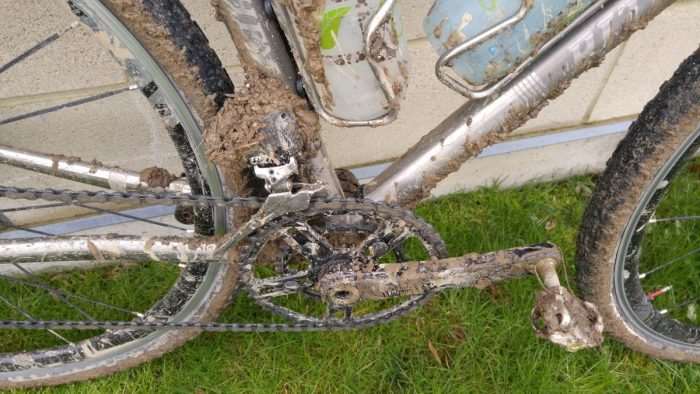
Not once has the crankset missed a shift. The earlier mentioned events include mud, sludge, well-groomed gravel, rocky gravel, heavy rain, desert-like conditions, single track, creek crossings and smooth pavement. Even under load, shifts are perfect from the small chainring to the big chainring. Shifts in the opposite direction are equally as flawless, although I soft pedal through when dropping rings.

I cannot vouch for 1x / single chainring performance, but the 46/30 sub-compact chainring pairing is superb. Combined with an 11-32 cassette, you can scale virtually any climb, seated, sans the large gaps often associated with a cassette designed for a 1x drivetrain. And, no creaking or groaning. Brilliant!
But, this review isn’t about the virtues of 1x versus 2x – but feel free to check out our video on that topic.
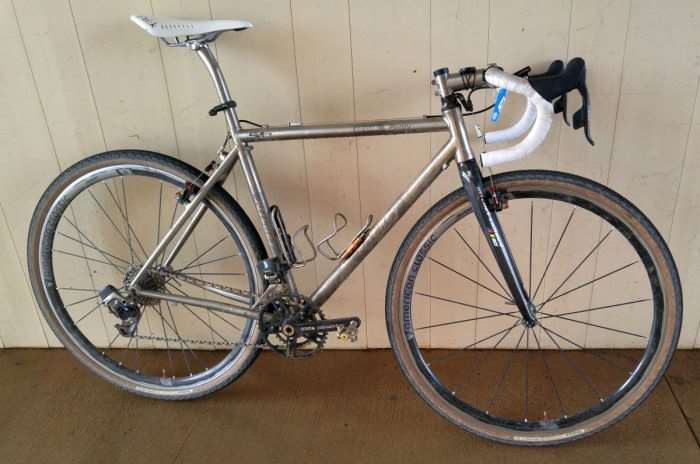
I have some small quibbles with the R30 crankset but they are very minor:
- Even at a Q-factor of 157.2mm for the R30 crankset, it is about 10mm more than Shimano’s Ultegra 6700 / 6800 series of cranksets. For people who have sensitive knees, this could be a point of concern. As for me, I barely noticed the additional 5mm either side.
- After a period of heavy use, the black anodizing can fade. The crankset is also available in polished silver, which completely avoids this problem.
- Regular service is needed on the bottom bracket, but this would apply to any bottom bracket, especially considering what I have put this crankset through in 2017. Paris to Ancaster was a bit messy, but the Almanzo 100 was a 7+ hour rainfest on sticky and gritty gravel roads. For maintenance, I was diligent about removing the bearing seals and applying fresh grease after every nasty ride or race. However, after nearly a year of use, it is time for the bearings to be replaced!
Summary
If you are looking for a crankset option that caters to lower gears with almost no limitations on chainring sizes for a 1x or 2x configuration, it is difficult to go past the White Industries R30 crankset. Performance is absolutely superb in even the nastiest of conditions.
At $US 300.00 for the crank arms and spindle, $US 100.00 for a bottom bracket and chainings ranging anywhere from $50 – $90 each, the costs soon add up, but pricing is on par with similar offerings on the market.
Finally, if you like supporting companies who design and manufacture their products in the USA – along with a long history of solid design principles and excellent customer service, do yourself a favor and check out the entire lineup of White Industries products. You will not be disappointed.


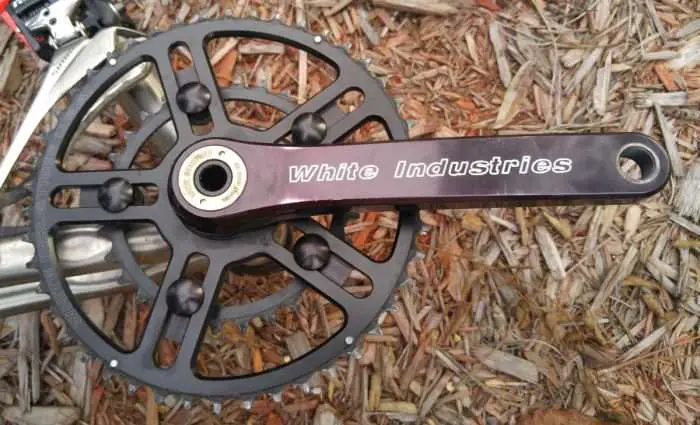


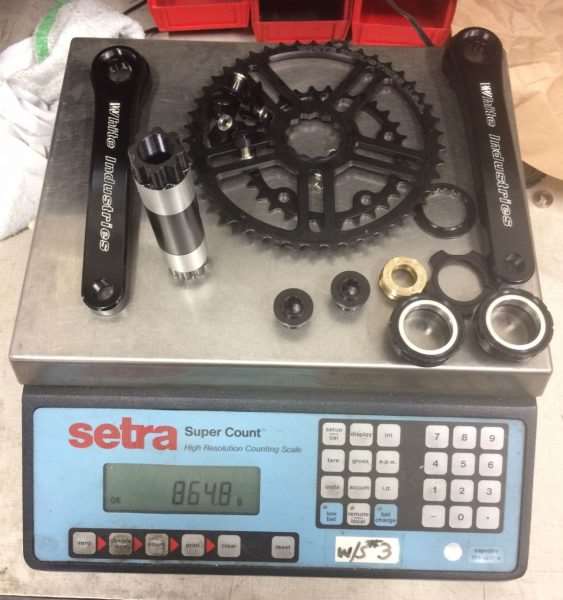
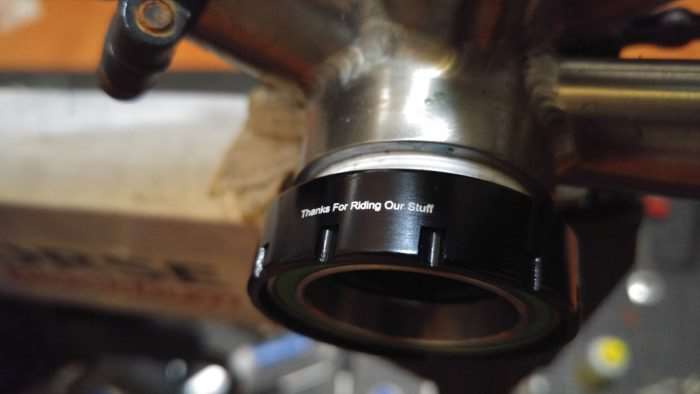

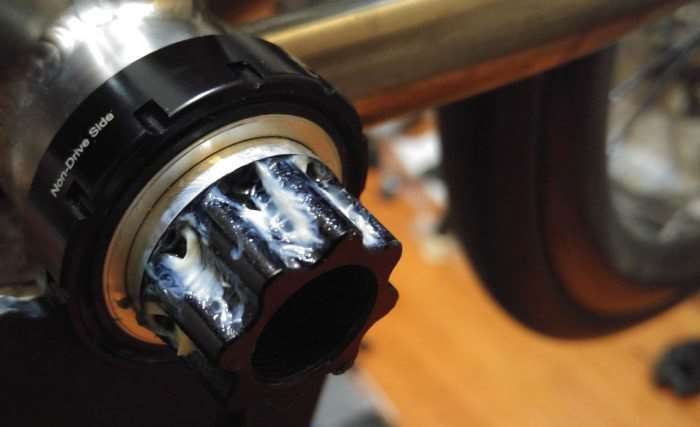
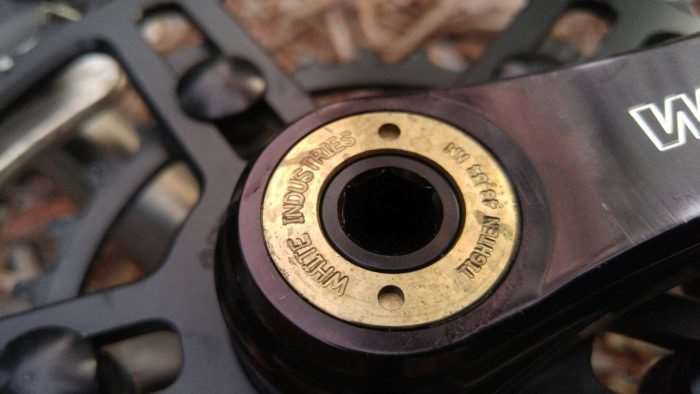
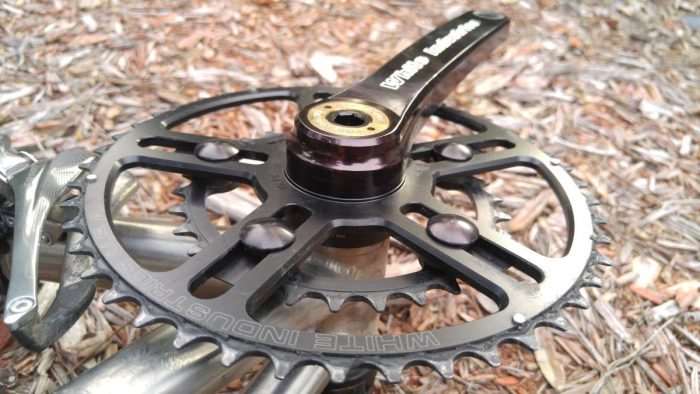
Been loving 44/24 R30’s
Nice!
Hi Jom – thanks for the review. I also have an eTap wifli gear set. I’m glad that the R30 is compatible. My main concern however is the eTap front der. What is the smallest large chainring that you think it can handle? The eTap works with my 46 large chain ring; but do you think it can handle a 44 or 42 from White VBC?
I bet White Industries would be able to give you an answer. They are quite good in the customer service area. 🙂
Bob, I don’t see why it wouldn’t handle those smaller rings. Generally, if the difference between the big ring and small ring is no more than 16 teeth, eTap seems to play well. You’ll just have to experiment.
JOM – thanks. I had some front. der problems with my first eTap install. But, that was probably because I accidentally crimped the down tube on my Swiss Cross — which made fine tuning the eTap front der. difficult. But the shape of the eTap is designed for the curve of larger road outside chain rings. In the past, I’ve had some difficulty making other standard road derailleurs work well with smaller big chain rings though. Some companies even make special front. der for smaller rings in XC or “compact” set ups. Lots of build projects going on now, but a 42/30 with an 11-32 rear der. would be perfect for me on the hilly unpaved roads of NH. Love the adaptability of the VBC.
1X is the way to go for anyone who has low cadence sensitivity. I’ve been running an 11-46 cassette since February on my primary road bike to great success, with one small caveat in that I really wanted a 42T cog (am running a 44T chainring), because there are lots of steeper hills where the 37T cog was too small, but the 46T cog was too big. I just upgraded this past weekend to an 11-50 cassette, and it is now absolutely perfect because it is basically like running an 11-42 10-speed with an extra 50T oh-sh!t cog for when I hit slopes >15%. I love 1X, and never plan to go back. If I still rode circular chainrings, the 1X version of this crank would be a lovely piece to have.
-Ed
Slightly off subject, but I want to get lower gearing on my stock Ultegra FC-6800 Di2, which is 50-36 X 11-32. I also want to retain the sweet Shimano shifting if possible.
Ideally, something like a 46-34 X 10-34 (don’t know if even exists) would be the range I’d be looking for. Any recommendations (or pitfals) greatly appreciated.
Hi there… I have used Shimano Ultegra Di2 6800 11-speed with 46 / 34 up front and an 11-36 on the rear. Cassette is a SRAM PG1170 11-36. You will need to use the medium cage rear Di2 derailleur with the B-screw turned in a good amount. Failing that, you can purchase the Wolftooth Roadlink which we have reviewed… you can shift a 36T cog no problem with that using an Ultegra Di2 short cage derailleur. This setup works very well.
Finally, a 10 tooth cog is not possible on a Shimano cassette body. Also, an 11-34 11-speed Ultegra level cassette from Shimano was put into production recently. Good luck!
Anyone have any thoughts on the process for deciding between the R30 Q-factor vs the G30 Q-factor? I personally never seem to notice the outboard spacing of my cranks, but with this crank being so $$$, I want to make sure I buy the right one. Thanks!
Ashley, I am all about the lowest Q-factor possible, so for me, it was a no-brainer to choose the R30.
Hi Jom. I have a Ritchey Breakaway Road that has an older octalink bottom bracket. After you upgraded the bottom bracket with outside bearings, did it affect the chainline? I am assuming your cross bike came with an inner bearing bottom bracket. Thanks!
Hey there, no issues with chainline, the bottom bracket shell in my bike is 68mm English thread, which will be the same as yours. At the moment, I’m using a FSA SLK carbon sub-compact crankset on the bike. Again, no issues with chainline.
Thank you, JOM! Appreciate your reporting. Will check out the FSA SL-K carbon sub-compact.
I just put the G30 with a White Ind. 42T TSR chainring for my All-City Nature Boy SS (which also has a White Ind 16/18T freewheel, headset, and custom wheelset with White Ind ENO hubs and Velocity Quill tubeless rims). All polished silver too. I love this crankset. Looks really cool and is very smooth and quiet. The fit and finish is second to none. WHite Inds. is super nice stuff.
Agreed, and USA made!
Is 45mm chainline on the road cranks as well?
yes.
JOM – you mentioned regular maintenance.
I’ve had my R30 (46-30) for only about 1.5k miles, but there’s some clicking happening from the left crank when I’m on the largest cog (32t). Not sure if it’s coming from the chain, but it sounds and *feels* like it’s coming from the BB. Always when I’m at the apex and f the pedal stroke, about to push downwards.
How often do you take apart and regrease the BB?
Thanks!
This sound could be anything. I like to use plumber’s tape on the BB cups when I install a threaded bottom bracket, I find that helps mitigate some noises. As far as regreasing, you will need to feel the bearings for wear with the crank removed. Then, if they do need grease, you will need to remove the lip seals from each cartridge bearing.
Hi,
I’ve got a grave adventure bike with a 68mm bsa bottom bracket. I’m building using Shimano road Di2 shifters and hydraulic brakes and mountain bike Di2 derailleurs.
As you are aware, the XTR Di2 sits drive side too far for a standard road crankset. The derailleur cage will rub in the top largest dogs of the rear cassette and the body of the front derailleur will make slight contact with the crank arm, a no go issue.
My question is do you know the spindle length of the set up you used in the review? You mentioned a slightly wider Q factor and I wonder if this will work for me as all I need is around 3 -5 mm more clearance to the drive side over a Sram Force Gpx crankset.
Sounds like this one or the gravel crank may work for me?
I would appreciate your comments.
Thank you,
Jay
Jay, Q-factor isn’t necessarily going to solve the XTR Di2 issue. Only a custom derailleur mount or 73mm shell will solve the problem of its location. As for the crank spindle length, sorry, I don’t know it. You will need to contact White Industries.
Have you experienced poor shifting with an Ultegra FD and the VBC setup? I can’t seem to get it to shift right.
Never tried it with an Ultegra FD, only an eTap generation one front derailleur.
Thanks for the quick response. Any experience running a road FD on a 73mm BB?
Hi JOM
I have watching your you tube clips and reading a few of your reviews, very interesting. After watching your review on Lynskeys GR250 and having always wanted a titanium frame decided to purchased a GR270 for my 50th.
So I’m now at the selecting components and build stage, this is my first dabble into gravel.
I have been considering the White Industries R30 cranks as I have been toying with the idea of shorter 165mm cranks (currently have 170 on my road bike), and seems not a lot of choose in 165mm available.
Haven’t settled on other components as yet, but thinking shimano GRX 2x shifters as its seems all the young cool kids are going this way. GRX rear derailleur, running 48/32 chain rings with cassette 11-32, I’m pretty light at 66kg I like hills but knees don’t. Wheel selection is some what harder, incredible amount of wheels to choose from, factory, shop brought or handmade, alloy or carbon? With the current exchange rate not being so kind its a big spend. Have you had experience with Roval c38? Also wondering is it possible to run standard Ultegra FD or do I need the GRX one? I know a bit broad but would greatly appreciate any advice you can share.
thanks
Dave
Hi Dave,
No experience with the Roval C38. I reviewed the 2020 Niner RLT 9 RDO and RLT 9 recently, both were kitted out with GRX 2x mechanical. The front derailleur was standard 11-speed Ultegra… worked like a charm. Now, they specd’ an Easton crank with 47/32 rings, so a 15T jump… Ultegra will handle a 16T jump no worries at all.
The White Industries stuff is top-notch, good luck!
Hi JOM
thanks for the reply, information greatly appreciated.
Regards
Dave
JOM,
Bizarre question maybe: In those first couple of pics without the chain installed, where the hell is your down tube? I realize my eyes are the oldest thing in my tool kit but something is amiss.
Mark
Mark, those are photos of the crankset with my Ritchey Breakaway Ti CX bike… whilst the frame halves are separated.